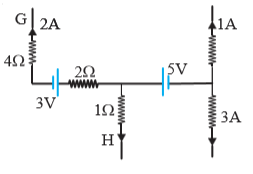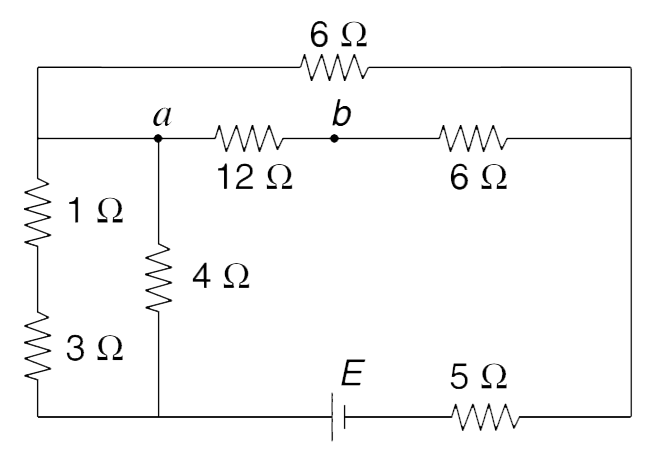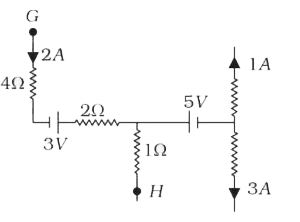In the part of a circuit shown in figure, the potential difference between points G and H (VG−VH) will be

0 V
12 V
7 V
3 V
The correct Answer is:C
The current distribution in a circuit is as shown in the figure.

Let VGandVH be the potentials at points G and H respectively.
∴VG−(2A)(4Ω)+3V−(2A)(2Ω)+(2A)(1Ω)=VH
VG−8V+3V−4V+2V=VH
VG−VH=7V
Topper's Solved these Questions
- CURRENT ELECTRICITY Book:MTG GUIDEChapter:CURRENT ELECTRICITY Exercise:CHECK YOUR NEET VITALS
Explore 16 Videos
- CURRENT ELECTRICITY Book:MTG GUIDEChapter:CURRENT ELECTRICITY Exercise:MCQs AIPMT / NEET
Explore 32 Videos
- CURRENT ELECTRICITY Book:MTG GUIDEChapter:CURRENT ELECTRICITY Exercise:MCQs AIPMT / NEET
Explore 32 Videos
- ATOMS AND NUCLEIBook:MTG GUIDEChapter:ATOMS AND NUCLEIExercise:AIPMT/NEET(MCQs)
Explore 40 Videos
- DUAL NATURE OF MATTER AND RADIATION Book:MTG GUIDEChapter:DUAL NATURE OF MATTER AND RADIATION Exercise:AIPMT/ NEET MCQs
Explore 30 Videos
Similar Questions
Knowledge Check
In the circuit shown in figure-3.331, the potential difference between points A and Bis :
 A207VB407VC107VDZero
A207VB407VC107VDZeroIn the part of a circuit shown in figure, the potential different
(VG−VH) between points G A0VB15VC21VD3V
A0VB15VC21VD3VIn the part of a circuit shown in fig. 5.266, the potential difference (VG−VH) between points G and H will be
 A0 VB15 VC7 VD3 V
A0 VB15 VC7 VD3 V

In the part of the circuit shown in the figure, the potential difference between points VA−VB=16V. The current passing through the 2Ω resistance will be
View SolutionIn the circuit shown in the figure, the potential difference between points aandb is Va−Vb=4V. Find the emf, E of the battery.

View SolutionIn the circuit shown, the potential difference between the points G and H, VG−VH is equal to _________ V.

View SolutionIn the circuit shown, the potential difference between the points G and H, VG−VH is equal to _________ V.

View SolutionIn the part of the circuit shown in the figure, the potential difference between points VA−VB=16V. The current passing through the 2Ω resistance will be

View Solution
